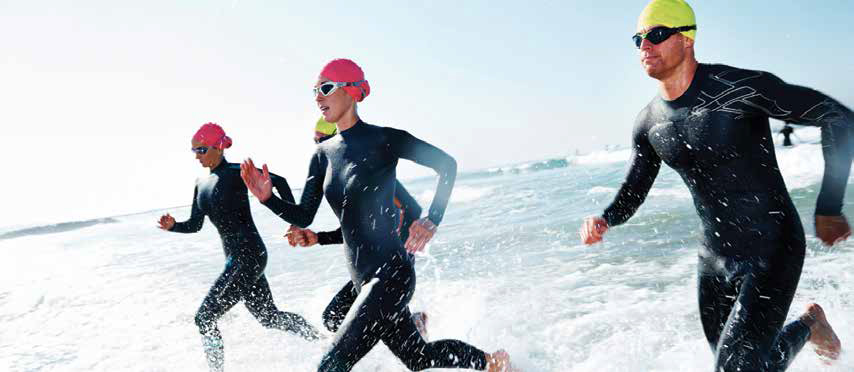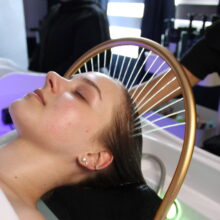Ferocious Fitness
- Published: Saturday, November 1st 2014
- in Living Well

Competitions like triathlons and popular High Intensity Interval Training Programs add ferociousness to fitness.
Fitness, like fashion, is often about what’s new, what’s different, what’s in and what’s out, with a hot new exercise fad seemingly being trumpeted every day.
In 2013 we looked at the exploding “label-conscious fitness” culture, which favors programs attached to the insider elite and/or a well-known brand. (Think Zumba®, The Biggest Loser® or Madonna’s Hard Candy™). And while name-brand fitness shows no sign of stopping, a new “ferocious fitness” trend is on the rise, led by people who take fitness seriously and who compete to establish their own “personal bests,” frequently at semi-professional levels.
Also driving this trend are popular High Intensity Interval Training Programs (HIIT), which add ferociousness in small bites and have become a mainstay for time-starved millions looking to take their fitness to the next level.
A key aspect of this new ferocious fitness is fun, and for many enthusiasts, fitness becomes the major ingredient in their social life. Fun also keeps motivation up: whether it is joining group training for a triathlon, getting energized at high intensity interval training programs, or participating in a dance class that leaves attendees on a happiness high, the common denominator is the sheer joy of working out.
And according to Edward L. Decci, PhD, a professor of psychology at the University of Rochester, people who work out for fun, rather than just focusing on results, keep at it longer and actually achieve better results.1
As people discover that exercise can be much more than a monotonous (and lonely) 45 minutes on a treadmill, and they experience significant results while having a good time, expect to see even more ferocious fitness in the year ahead – and a new culture where people rush from work to join their running club or HIIT class.
FUELING THE TREND
Walks, Runs, Rides and Marathons
Legend has it that the word “marathon” can be traced to 490 B.C. when the Greek messenger Pheidippides ran from the Battle of Marathon to Athens to announce the Persian army had been defeated. (According to the same legend, he collapsed and died on arrival.) When the Olympics were established in 1896, a marathon race was one of the first competitions. Now there are more than 500 official marathons staged around the globe, and that doesn’t include the tens of thousands of 5K runs, 10Ks runs, triathlons, pentathlons, bike races, walks, fun runs and more held worldwide.
And many of these runs, races and walks have a greater purpose since they are organized for a cause. The actor/comedian Ramón Rivero is credited with holding the first walkathon in 1953 in San Juan, Puerto Rico, to raise money to fight cancer.2 Today, millions of people around the world ask friends to sponsor them in events ranging from three-mile “fun runs” to 100-mile bike treks. There are tens of thousands, if not hundreds of thousands, of events taking place across the globe held to raise money to fight disease, support schools and feed the poor.
All this running, cycling and swimming means tens of millions of people training – often in groups – and having a lot of fun doing it.
Reality Entertainment Feeds Real-World Fitness
Reality television dates back to the 1940s when shows like Queen for a Day was a hit, but reality shows weren’t identified as a genre until the early 1990s when The Real World first aired.3
Today there are hundreds of reality programs, which have become a staple of TV programming around the globe and often enjoy top ratings. (According to the UK’s Daily Mail, producers are working on 170 new shows.) Popular reality sub-genres include shows focusing on lifestyle changes and sports/adventure competitions, such as The Biggest Loser, Extreme Makeover, Celebrity Fit Club, The Amazing Race and Survivor.
For many viewers, engagement with these shows isn’t simply passive. Millions of fans who watch shows that reward participants for winning fitness competitions or making lifestyle changes are inspired to make drastic positive changes in their own lives. There are even Biggest Loser Resorts, which have grown to four locations.
Our Competitive Natures
By nature humans are competitive, and sports competition in particular is finely tuned at an early age. According to a recent study on youth sports4, in the U.S. alone, there are 21.5 million kids playing team sports between the ages of six and 17, and 60 percent of boys and 47 percent of girls are on a sports team by age six. The Taking Part survey, conducted for the Department of Culture, Media and Sports in the U.K., showed that the majority of adults who play sports also played as children.5 Imagine how many sports enthusiasts there are with a pent-up demand to compete on a higher level.
Hollywood-based trainer John Colella sees a new competitiveness in his celebrity clients. “Today they want to compete against me—who can lift more, who can run faster, who performs best.” Colella points out that not every one is ready for more extreme fitness, and he sometimes has to (tactfully) encourage clients to focus on programs that are more appropriate for their ability.
A “Ripped” Celebrity Culture
Throughout this trends report you’ll see references to the staggering influence of the US$2.2 trillion global entertainment and media industry and the impact it has on a celebrity-obsessed population. As stars from Bollywood to Hollywood embrace the fit lifestyle – and enjoy lucrative fitness-related branding and endorsement opportunities – expect to see celebrities have even more influence on the way we live and look. (It is inspiring to see Bollywood celebrities motivating people in India to be more fit, as obesity has become more common in recent years.)
And Don’t Forget Marketing
According to IBS World6, revenue for gym, health and fitness clubs in Canada alone in 2013 was US$2 billion. A lot of that money is then being reinvested in marketing to attract an even larger share of the fitness-obsessed public.
Extreme Fitness. Extreme Results

Take a quick look at most fitness club menus (and increasingly menus at destination spas and wellness retreats) and you’ll see more adjectives like “killer,” “over drive,” “extreme,” “primal,” “hardcore” and “boot camp” and less of “gentle” and “easy.” How intensely a person trains has become a new status symbol.
The Body Holiday LeSPORT, the famous wellness resort in St Lucia, offers a variety of intense fitness programs, including marathon-training and mediumand long-distance swimming, combined with total immersion training. Beach Fit, the spa’s highestintensity class is an extremely popular workout; 150 to 200 people start exercising at 7 a.m., and much of the workout is high intensity.
According to Andrew Barnard, deputy managing director, “People stretch themselves with strenuous mountain hikes and climbing. I think that a lot of wellness destinations have marketing pictures of people sitting and meditating, but behind those pretty pictures is cardio burn.”
Competitive For a Cause
Athletic fundraising has gone mainstream, with numerous nonprofits (American Cancer Society, Susan G. Komen Walk for the Cure, Cancer Research UK, Walk the Walk in Paris to name a few) raising JDRF’s Ride to Cure Diabetes attracts thousands of riders and has raised $20 million for T1D research. Photo courtesy of JDRF 2014 TRENDS REPORT 34 Spafinder Wellness 365™ money through walkathons, bikeathons, and funrun events.
And many of these fundraisers require more than just a day’s commitment from participants. The JDRF Ride to Cure Diabetes, for example, offers cyclists the chance to train with a USA Cycling certified coach before hitting the road for rides designed for all fitness levels. Cyclists then meet up to take part in a weekend that includes safety seminars, planned excursions, and team-building celebrations. This all leads up to the big event: Ride Day.
But according to an article in London’s Daily Express, running a single marathon or riding a marathon is no longer enough if you want to raise money. “So many people are taking part in physical challenges and posting them all over social media,” says Dr. Richard Godfrey, senior lecturer in sports coaching and human performance at Brunel University in London. “To stand out it is becoming necessary to do something extreme.” The article profiled Dave Knowles, a 29-year-old account manager, who is running 13 marathons in 13 days to raise money for Motor Neuron Disease.7
High-Intensity Interval Training (HITT)

Popular since the 1970s, High Intensity Interval Training (HIIT) is making an appearance in more extreme fitness programs and has been showing up again on top 10 fitness lists, thanks in part to its popularity with people who are either strapped for time or don’t want to spend time on longer fitness regimes. Adding credibility to the program is a study published in the American College of Sports Medicine’s Health & Fitness Journal (as covered in an upcoming New York Times Magazine column), in which two experts claim that a combination of 12 exercises done over the course of seven minutes can be just as good for you as hours spent on other kinds of exercise.
As defined by the highly successful TRX program, founded by former Navy Seal Randy Retrick, HIIT “refers to workouts where you perform exercises at a near-maximal effort for specific intervals of time, with or without rest between movements.” Advocates of HIIT workouts say they save time and take exercise to the next level; there are numerous programs on the market, all teaching the same basic philosophy.
HIIT is making its way to spas too. At the awardwinning Gwinnganna Lifestyle Retreat in Queensland, Australia, guests are encouraged to include both functional movements and intense interval training in their fitness programs. Tracy Willis, marketing manager, points out that, “(HIIT) is by nature a ferocious way to train: short bursts of high intensity, such as a challenging hike uphill, and then enjoying the view in the recovery phase. And the method can be applied to boxing, indoor cycling or resistance training.” Gwinganna also caters to all levels of fitness and physical limitations and always offers guests a choice between yin and yang, the gentler or the more intense.
Another HIIT workout is the Tabata Protocol, created by Izumi Tabata for Japanese Olympians in the 1970s. This one is based on an intensely cardiodriven routine consisting of a five-minute warm-up, followed by eight 20-second intervals of an all-out intensity exercise, followed by 10 seconds of rest, and then two minutes of cool-down. Described on tabataprotocol.com as “the world’s greatest fat burning workout,” it is said to also build muscle when practiced just three days a week.
And of course CrossFit, a high-intensity intervaltraining fitness regimen, developed by Coach Greg Glassman, has become extremely popular around the globe and now has 5,500 affiliated gyms and more than 35,000 accredited trainers. CrossFit is also a community, and the brand has created the Sport of Fitness, known as the CrossFit Games, where the Fittest Man and Woman on Earth are crowned.
Athletes Just Gotta Have Fun

There are arguably thousands of fitness dance classes around the globe that are designed to be fun for participants. GROOV3, with locations across Los Angeles, is taking fun and ferociousness to the max, with dance workouts featuring a live DJ in every class. Founder Benjamin Allen, a professional dancer and choreographer, created GROOV3 for nonprofessionals but expert dancers often stop by, which only amps up the intensity.
“When I first started teaching, I realized that people just wanted to have fun,” says Allen. “At GROOV3 there is no disciplined routine, and we guide dancers with hand signals so they can add their own flavor. We’re building a community of people who come together for an hour and let go of their stresses and worries through the euphoria of music and dance.”
The Call of the Wild
Military-style boot camps in general (the fitness variety, not the correctional kind) have become highly popular. In 2013 Cheapflight.com named the world’s Top 10 Fitness Boot Camps, a list that included destinations like the female-only, G.I Jane boot camp in Kent, England; the Luxury Algarve Bootcamp in Algarve, Portugal; the Raw Fitness Boot Camp in Phuket, Thailand; and a seven-day climb up Kilimanjaro (Tanzania) led by mountain experts from British Military Fitness.
Taking races (and camaraderie) up a great many notches are themed competitions like Tough Mudder (UK, Australia and US), which bills itself as “Probably The Toughest Event on The Planet™.” Each Tough Mudder hardcore obstacle course has 10 to 12 miles of “hills, mud, water, ropes, walls, electric shocks and fire designed to push you to your limit.”
Founder and CEO Will Dean is from the UK and previously worked for the Diplomatic Service, overseeing UK Overseas Counter Terrorist Finance Operations.
Over one million men and women worldwide have put themselves to the Tough Mudder test to date, and the company has raised nearly US$6.5 million for the Wounded Warrior Project. Participants can train for the events at a Tough Mudder Boot Camp, and 80 percent of these tough mudders are members of a team.
The Ferocious Future
Not so long ago the world was neatly divided into two distinct parts: developed and undeveloped countries. Organized fitness programs primarily occurred in more prosperous Western nations, and the rest of the world stayed fit by working outdoors for long hours, walking or running (not driving), and just living life. But that has all changed now that people in developing countries eat more processed food and work at sedentary jobs. In these nations, obesity is unfortunately reaching epidemic proportions.
Will this newly out-of-shape and overweight global population join fitness enthusiasts who are already pumped on extreme fitness? And can a brave, new, healthier world be far behind for all of us?
- MSNBC, December 12, 2013
- Puerto Rican League Against Cancer and Wikipedia
- Wikipedia
- ESPN, “The Hidden Demographics of Youth Sports,” July 11, 2013
- The Taking Part survey, conducted for the Department of Culture, Media and Sports, UK, 2009
- IBIS World, Gym, Health & Fitness Clubs Market Research Report, NAICS 71314CA, November 2013
- The Daily Express, “Pushing beyond our limits: Taking on extreme challenges for charity,” December 10, 2013.
TOP 10 SPA & WELLNESS TRENDS FOR 2014
- Healthy Hotels 2.0
- Wired Wellness
- Hot Springs Heating Up
- Suspending Gravity
- Ferocious Fitness
- Natural Beauty Meets Social Media
- Aromatherapy: Scent with Intent
- Wellness Retreats Rise… & Urbanize
- Death & Spas: Thriving During Life’s Transitions
- Top 10 Surprising Spa & Wellness Destinations



